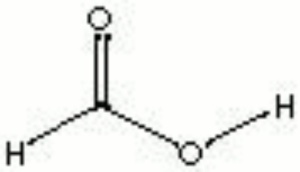Difference between revisions of "Formic acid"
m (Text replace - "== Authority ==" to "== Sources Checked for Data in Record ==") |
|||
| Line 8: | Line 8: | ||
[[[SliderGallery rightalign|formic acid.jpg~Chemical structure]]] | [[[SliderGallery rightalign|formic acid.jpg~Chemical structure]]] | ||
| + | == Hazards and Safety == | ||
| + | |||
| + | Combustible. Flash point = 69 C. Will corrode metals. | ||
| − | == | + | Inhalation and skin contact will cause irritation and burns. |
| + | |||
| + | ThermoFisher: [hhttps://www.fishersci.com/store/msds?partNumber=A118P100&productDescription=FORMIC+ACID+ACS+100+ML&vendorId=VN00033897&countryCode=US&language=en SDS] | ||
| + | == Physical and Chemical Properties == | ||
Miscible with water, ether, acetone, ethyl acetate, methanol, ethanol. Partially soluble in benzene, toluene, xylenes. | Miscible with water, ether, acetone, ethyl acetate, methanol, ethanol. Partially soluble in benzene, toluene, xylenes. | ||
| Line 35: | Line 41: | ||
| 100.8 | | 100.8 | ||
|} | |} | ||
| − | |||
| − | |||
| − | |||
| − | |||
| − | |||
| − | |||
| − | |||
| − | |||
== Comparisons == | == Comparisons == | ||
| Line 48: | Line 46: | ||
[[media:download_file_129.pdf|Properties of Common Solvents]] | [[media:download_file_129.pdf|Properties of Common Solvents]] | ||
| − | + | == Resources and Citations == | |
| − | |||
| − | == | ||
* Richard S. Lewis, ''Hawley's Condensed Chemical Dictionary'', Van Nostrand Reinhold, New York, 10th ed., 1993 | * Richard S. Lewis, ''Hawley's Condensed Chemical Dictionary'', Van Nostrand Reinhold, New York, 10th ed., 1993 | ||
Revision as of 09:03, 30 October 2020
Description
A colorless, fuming liquid with a strong pungent odor. Formic acid occurs naturally in the poison of stinging ants and in stinging nettles. In air, Formaldehyde will oxidize slowly to form formic acid. Formic acid is a strong reducing agent and will react quickly with most materials. It is deleterious to metals and may harm oil paintings, watercolors, drawing, and sketches. Formic acid is sold commercially as an aqueous solution. It is used industrially in animal feeds, textile dyeing, leather tanning and in the production of insecticides, rubber, and refrigerants. In textile dyeing, formic acid is used to assist in the absorption of Chromium mordants.
Synonyms and Related Terms
hydrogen carboxylic acid; methanoic acid; aminic acid; formylic acid
Hazards and Safety
Combustible. Flash point = 69 C. Will corrode metals.
Inhalation and skin contact will cause irritation and burns.
ThermoFisher: [hhttps://www.fishersci.com/store/msds?partNumber=A118P100&productDescription=FORMIC+ACID+ACS+100+ML&vendorId=VN00033897&countryCode=US&language=en SDS]
Physical and Chemical Properties
Miscible with water, ether, acetone, ethyl acetate, methanol, ethanol. Partially soluble in benzene, toluene, xylenes.
pH (0.1 N aqueous solution) = 2.3
| Composition | HCOOH |
|---|---|
| CAS | 64-18-6 |
| Melting Point | 8.4 |
| Density | 1.220 |
| Molecular Weight | mol. wt. = 46 |
| Boiling Point | 100.8 |
Comparisons
Resources and Citations
- Richard S. Lewis, Hawley's Condensed Chemical Dictionary, Van Nostrand Reinhold, New York, 10th ed., 1993
- The Merck Index, Martha Windholz (ed.), Merck Research Labs, Rahway NJ, 10th edition, 1983 Comment: entry #4268
- Matt Roberts, Don Etherington, Bookbinding and the Conservation of Books: a Dictionary of Descriptive Terminology, U.S. Government Printing Office, Washington DC, 1982
- S.R.Trotman, E.R. Trotman, Textile Analysis, J.B. Lippincott Company, Philadelphia, 1932 Comment: specific gravity = 1.241
- John and Margaret Cannon, Dye Plants and Dyeing, Herbert Press, London, 1994
- The American Heritage Dictionary or Encarta, via Microsoft Bookshelf 98, Microsoft Corp., 1998
- Susan E. Schur, Conservation Terminology: A review of Past & Current Nomenclature of Materials, Technology and Conservation, Spring (p.34-39); Summer (p.35-38); Fall (p.25-36), 1985
- CRC Handbook of Chemistry and Physics, Robert Weast (ed.), CRC Press, Boca Raton, Florida, v. 61, 1980 Comment: pH (0.1 N aqueous solution) = 2.3
